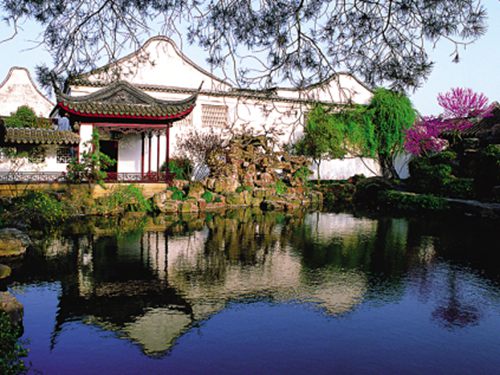Classical Chinese garden enjoys a sound reputation among tourists from foreign countries and domestic regions. Most of the famous gardens are situated in Yangtze River Delta Region, of where the gardens often share same architectural elements.
Classical Chinese gardens were mostly built adjacent to private residences. The past owners of the gardens were usually retired government officials, who took the natural landscape as their model for creating artistic garden scenery. They would invite the social elite to gatherings in their gardens. The gardens were therefore, in effect, a continuation of the living space, including reading, painting, writing and reading out poetry, playing music, tasting tea and wine, playing chess and banqueting.

As such, the crafting of classical gardens was designed to be functional as well as aesthetic living space where the natural and manmade worlds were closely incorporated. The following aspects were all considered:
1. Water features
Situated near the Yangtze River, Jiangsu has the advantage of easy access to the river to build water features. In addition to artistic concerns, the ponds and streams were also used to provide irrigation and lessen the risk of fire. Therefore, a large number of garden designers use water features as the theme of the garden. In a lot of classic gardens, you may find that the bodies of water located in the middle of the garden were surrounded by pavilions and halls connected by verandas. Small bridges crossed the water to provide easy access.
2. Rockeries
During the Qing dynasty (1644-1911), the use of lake stones in rockery design became popular. The number of rockeries and the quality of each single rockery then became the sole criterion for evaluating the superiority of a garden. When there was no readily available water source or low land within the garden, it became necessary to use hills and rocks as themes to accentuate the landscape.
3. Picture windows
Picture window is regarded an important element of ancient Chinese architectural art. Many halls and verandas opened to gardens through picture windows that frame the landscape and bring the outdoors inside. Unlike a static painting, the objects in the window change color and content in different seasons and weather conditions, and the view moves, as wind blows bamboo or a bird comes into the frame.
4. Plants
In the classic Chinese gardens, plants can be set against hills, around ponds and near constructions to form picturesque scenery. There is an interesting saying to explain the importance of plants, “Plants in a garden are like hair on a person, making up an essential element of the garden's ecological environment.”
The chosen plants were usually traditional local species, planted naturally to form a landscape of mountain forests, which change colors in different seasons. Among them, ancient trees were of special value, as they served as silent witnesses of history. In Jiangsu's gardens, trees older than 100 years are commonly found.
